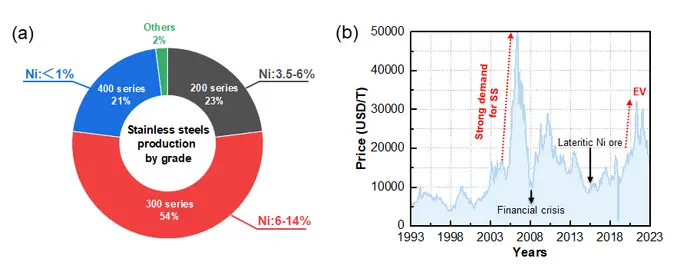
In recent years, the global demand for nickel has surged due to its essential role in the production of stainless steel. More than 70% of the world’s nickel supply is dedicated to this strong, corrosion-resistant alloy, which finds applications across various sectors, including construction, transportation, and medical device development. However, as fluctuations in nickel supply become increasingly prominent, researchers face significant challenges in maintaining both the quality and stability of stainless-steel production. This urgent need for sustained manufacturing processes has led to promising innovations in material science, particularly in the realm of stainless-steel alloys.
A recent study conducted by a collaborative team from Tohoku University and Tsinghua University has unveiled groundbreaking developments in the fabrication of nickel-free stainless steel. As structural integrity and sustainability take center stage in modern manufacturing, understanding how to effectively reduce reliance on nickel while preserving the material’s strength became a critical objective for researchers. Run-Zi Wang, an assistant professor at Tohoku University’s Advanced Institute for Materials Research, highlights the challenges of balancing these dual demands.
The researchers focused on the creation of a new stainless-steel alloy that eliminates the need for nickel entirely. Their findings, published on December 27 in the journal Additive Manufacturing, outline an innovative solution to stabilize production costs while addressing the urgent need for sustainability. The development of this new alloy represents a significant advancement in metallurgical engineering, as it allows for the continued use of stainless steel while reducing the consumption of this precious metal.
The research highlights the particular advantages of ferritic stainless steel, which is classified as nickel-free and primarily magnetic. This type of stainless steel has garnered renewed interest as an alternative for industries that traditionally rely on nickel-containing austenitic stainless steel. However, the ferritic variant has faced challenges due to its lower fracture strength and hardening rate compared to its austenitic counterpart. In seeking to address this issue, the research team explored hybrid bimetallic structures that combine both types of stainless steel.
By utilizing additive manufacturing—a sophisticated form of 3D printing—Wang and his team were able to fabricate composite structures integrating nickel-free ferritic stainless steel with austenitic stainless steel. This technique, known as wire-arc directed energy deposition, involves the precise deposition of metal layers. By allowing two distinct types of stainless steel to coexist within a single framework, the researchers aimed to leverage the strengths of both materials while mitigating the drawbacks associated with each.
The analysis of the resulting bimetallic structure revealed noteworthy enhancements in elemental distribution and mechanical properties. The interface where the two metals met exhibited features suggesting an increase in hardness and strength, surpassing what could be achieved by each component on its own. This interplay between materials not only unlocks new applications for stainless steel but also sets the stage for novel manufacturing techniques that promise to revolutionize the industry.
This research is not merely an academic exercise; it bears considerable implications for industries heavily reliant on stainless steel. By fostering manufacturing practices that are both cost-effective and environmentally sustainable, the study contributes to a more resilient industrial landscape. The ongoing transition to lower-cost and durable materials is expected to have profound benefits for consumers, ranging from reduced construction expenses to improved durability of medical devices.
Looking ahead, the implications of this research extend beyond immediate applications in manufacturing. As industries strive to meet the demands of a changing world, the integration of sustainable resources and innovative production methodologies will be critical. This advancement in stainless-steel production could inspire a new wave of research into alternative materials and hybrid systems, ultimately steering the market toward greener practices.
As industries face ongoing pressure to adopt sustainable practices, the successful implementation of nickel-free stainless steel stands as a testament to innovative problem-solving in material science. Researchers and manufacturers alike can harness these findings to spark further advancements, ensuring that material integrity is maintained without compromising environmental responsibility.
The study conducted by Tohoku University and Tsinghua University points to a future where the reliance on critical metals like nickel may be significantly reduced without sacrificing performance or quality. This innovative leap can fundamentally alter the trajectory of stainless steel production, opening doors to further exploration of alternative alloys and manufacturing methods that align with contemporary sustainability goals.
These revelations may also provide a roadmap for future research initiatives aimed at developing new materials that fulfill similar roles across a myriad of industrial applications. Given the global push for sustainability in manufacturing, it is critical for scientists and engineers to explore diverse avenues that contribute to this transition.
In conclusion, the collaboration between Tohoku University and Tsinghua University stands as a beacon of hope for the materials engineering community. The emergence of a reliable nickel-free stainless steel could not only stabilize costs but also create a more sustainable future for manufacturing. Continued research and innovation in this domain will be essential for addressing the complex challenges posed by modern production demands.
Subject of Research: Development of a Nickel-Free Stainless Steel Alloy
Article Title: Interfacial characteristics and microstructural evolution of austenitic to ferritic stainless steels bimetallic structure fabricated by wire-arc directed energy deposition
News Publication Date: 27-Dec-2024
Web References: DOI Link
References: None provided in the original content
Image Credits: ©Yipu Xu et al.
Keywords
Additive Manufacturing
Steel
Nickel
Industrial Production
Materials Science
Physics
Tags: advancements in stainless steel fabricationchallenges in stainless steel productioncollaborative research in materials engineeringeconomic impacts of nickel supply fluctuationsenvironmental considerations in metal productionfuture of stainless steel manufacturingmaterial science breakthroughs in alloysnickel-free stainless steel innovationspreserving nickel resources in alloysroles of nickel in stainless steel applicationsstrategies for sustainable material manufacturingstructural integrity of nickel-free alloys





